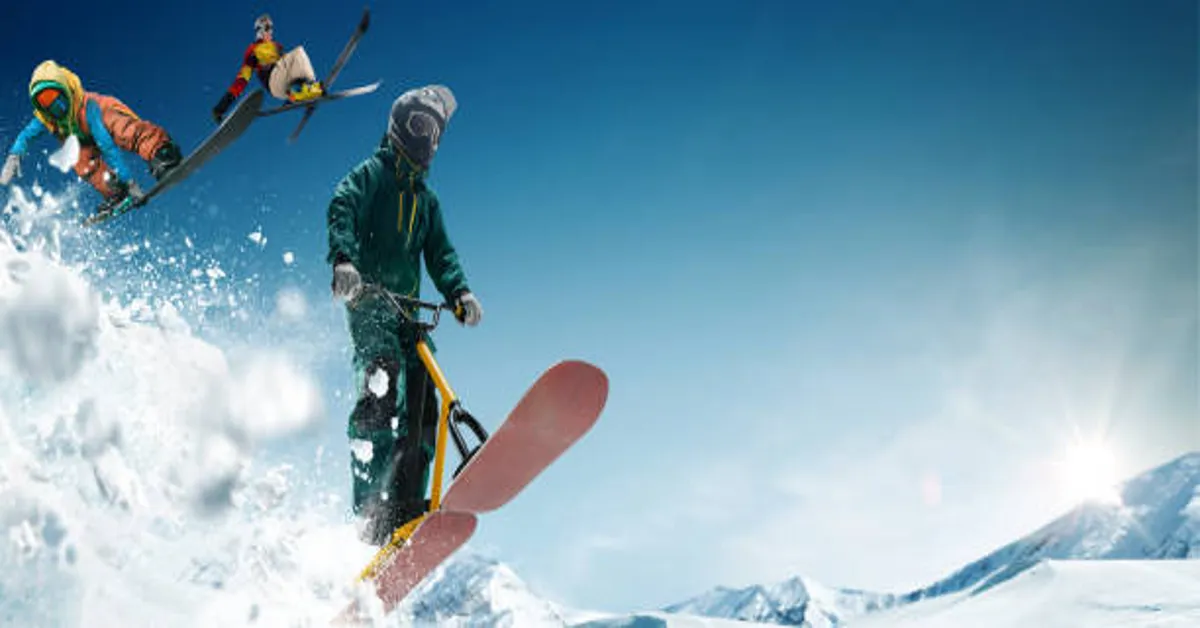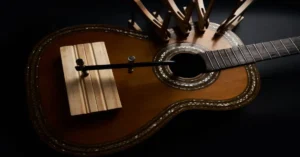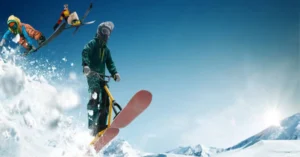Winter sports have always offered a fascinating mix of adventure, challenge, and speed. From snowboarding and traditional skiing to cross-country and alpine disciplines, snow enthusiasts have developed countless ways to glide across icy terrain. Among these, monoskiing stands out as a unique and lesser-known approach to downhill snow sports. Its distinct design, physicality, and subculture have made it an intriguing option for adrenaline seekers and innovation lovers alike.
Although monoskiing is not as mainstream today as some other winter sports, it carries a rich history and still garners a dedicated following. Whether you’re hearing the term for the first time or you’ve seen it on the slopes and wondered how it works, this article aims to give you a complete understanding of monoskiing—exploring its origins, techniques, equipment, training requirements, applications in adaptive sports, and how it compares to other disciplines like skiing and snowboarding.
We will explore monoskiing in its two primary interpretations: as a recreational downhill snow sport using a single wide ski, and as a form of adaptive skiing using seated mono-equipment for athletes with physical impairments. Both variations are vital to the evolution and identity of the sport and provide opportunities for different types of athletes and enthusiasts.
Understanding What Monoskiing Is
At its most basic, monoskiing refers to the practice of skiing on a single wide ski, with both feet attached side by side, facing forward. This is different from traditional alpine skiing, where each foot has its own independent ski, and snowboarding, where both feet are fixed sideways on a single board.
In monoskiing, the rider uses standard ski poles and faces directly downhill—similar to alpine skiers—but their stance is fixed side-by-side on one ski, requiring unique balance and technique. The result is a sensation often described as “floating” or “surfing” on snow, combining elements of skiing’s forward motion with the carving mechanics more typical of snowboarding.
There is also an adaptive form of monoskiing, commonly referred to in the world of paralympic sports, where an individual sits in a bucket seat attached to a single ski with outriggers for balance. This version is crucial for accessibility, allowing individuals with lower-limb impairments to participate in alpine skiing with confidence and independence.
Both forms of monoskiing share a reliance on dynamic balance, edge control, body positioning, and an awareness of terrain—but they serve different communities and require their own sets of equipment and skill development.
The History of Monoskiing
The recreational version of monoskiing dates back to the 1960s and 1970s, primarily gaining traction in European alpine regions such as France and Switzerland. During this period, skiing culture was experiencing a phase of experimentation. Equipment innovation was flourishing, and outdoor enthusiasts began experimenting with different ways to descend snowy slopes. Snowboarding was still in its infancy, and monoskiing emerged as an alternative for thrill-seekers who wanted the fluidity of a snowboard but the orientation of traditional skis.
Monoskis were developed using broader platforms and bindings mounted side-by-side, allowing both feet to face forward. Skiers enjoyed the speed and carving capacity this setup offered, especially in deep powder. However, as snowboarding rose to dominate the winter sports landscape in the 1980s and 1990s, monoskiing gradually took a backseat in popularity.
In parallel, the adaptive monoski was also being developed for physically disabled athletes. Beginning in the late 1970s and early 1980s, adaptive skiing communities, often led by veterans and medical professionals, created seated rigs with shock absorption, harnesses, and single skis. This allowed athletes with amputations, spinal cord injuries, or other mobility issues to engage in downhill skiing. The adaptive monoski later became a core part of Paralympic alpine skiing and remains one of the most advanced forms of adaptive sports equipment available today.
Today, while recreational monoskiing is a niche passion, it’s seeing something of a revival among retro sports lovers, adventurers seeking new challenges, and fans of powder skiing. Adaptive monoskiing continues to advance technically and competitively, with innovation driven by both athletes and engineers.
The Equipment Used in Monoskiing
Monoskiing equipment differs based on whether you’re using the recreational or adaptive version of the sport. In both cases, specialized gear is essential for safety, performance, and control.
Recreational Monoski Equipment
- Monoski Board: The central piece of equipment is a wide, single ski board typically between 170–200 cm long and significantly wider than regular skis. It has sidecut for carving and a flex pattern suited to balancing both feet on a single surface. The bottom features steel edges and a cambered profile for grip and turning precision.
- Bindings: Standard alpine bindings are mounted side by side on the monoski, allowing both feet to face forward in a natural stance. These bindings must be adjusted carefully for proper weight distribution and release settings.
- Ski Poles: Two ski poles are used, much like traditional skiing, to assist with balance, initiation of turns, and maneuvering at lower speeds.
- Boots: Regular alpine ski boots are typically used. Since foot movement is restricted, boots need to offer both stiffness and comfort.
- Helmet and Goggles: Safety gear like helmets and goggles is essential, as falls at high speed can be more forceful due to the equipment’s width and balance demands.
Adaptive Monoski Equipment
- Mono-Sit-Ski or Mono-Rig: This rig consists of a bucket-style seat mounted on a metal frame with shock absorbers, which is then attached to a single ski beneath it. The setup is engineered to distribute weight evenly and absorb impacts from uneven terrain.
- Outriggers: These are short ski poles with miniature skis on the bottom, allowing the athlete to control balance, direction, and speed while seated. Outriggers often have locking and pivoting features for different modes of skiing.
- Harness System: Some users, especially beginners or athletes in early recovery phases, may use a tethered harness to allow instructors to guide their descent and assist with braking.
- Protective Gear: Given the lower center of gravity and increased risk of tipping at high speed, adaptive monoskiers use full protective gear, including body armor, gloves, helmets, and sometimes neck braces.
Each version of monoskiing demands an understanding of its gear—not just how to use it, but how to maintain, inspect, and adjust it based on skill level, snow conditions, and performance goals.
Technique and Learning Curve
The technique used in monoskiing shares some similarities with both skiing and snowboarding but also includes unique challenges. For beginners, the initial adjustment can feel awkward due to the close proximity of the feet and the difference in edge control.
Learning Recreational Monoskiing
Learning to monoski begins with understanding weight transfer and edge control. Because both feet are on the same board, the rider must shift weight laterally across the whole ski, rather than individually like in alpine skiing. This makes turn initiation feel smoother but also requires more commitment to each motion.
Instructors usually teach monoskiers the following skills in progression:
- Balance in Neutral Stance: Understanding how the center of gravity sits on the wide ski surface.
- Straight-Line Gliding: Moving without turning to understand glide and friction.
- Carving and Edge Transitions: Practicing S-shaped turns using full ski edge engagement.
- Pole Usage: Learning how to use poles for timing and rhythm.
- Powder Techniques: In deep snow, monoskiers experience better floatation but must learn new turning strategies due to snow resistance.
Advanced monoskiers focus on dynamic carving, high-speed descents, jump landings, and off-piste terrain. The learning curve can be moderate if the rider has prior experience with skiing or snowboarding but steeper for complete beginners.
Learning Adaptive Monoskiing
For athletes using the sit-ski version, learning involves upper body control, outrigger coordination, and trunk balance. Most instruction begins on groomed slopes with assistance.
Training milestones may include:
- Mounting and Dismounting: Entering and exiting the sit-ski independently.
- Balance Exercises: Using core strength to control the ski from a seated position.
- Outrigger Practice: Mastering turning, braking, and gliding with adaptive poles.
- Lift Loading: Learning to safely board and disembark chairlifts.
- Advanced Maneuvers: Techniques for carving, moguls, and competitive racing.
Adaptive monoskiers often train under the supervision of certified instructors and may participate in specialized programs or competitions such as the Paralympics.
Safety and Risk Management
Like any snow sport, monoskiing carries inherent risks, especially due to the specialized equipment and high-speed nature of the sport. Safety protocols, responsible behavior, and appropriate preparation are critical.
Common safety considerations include:
- Protective Gear: Always wear helmets and wrist guards. For adaptive skiers, additional padding is strongly advised.
- Proper Binding Settings: Adjust release values on bindings to avoid injury during falls.
- Pre-Ride Equipment Check: Inspect your monoski, poles, boots, and seat mountings every session.
- Weather and Terrain Awareness: Avoid skiing in low visibility or avalanche-prone areas without proper precautions.
- Controlled Descent: Especially for beginners, maintain safe speeds and avoid abrupt terrain changes.
- Know Your Limits: Gradually progress to harder trails or freestyle terrain; overconfidence often leads to injury.
For adaptive monoskiers, having access to trained instructors, emergency support, and accessible lift services is essential for both safety and enjoyment
Monoskiing in Competitive and Recreational Settings
Recreational monoskiing is most often enjoyed in alpine resorts that welcome diverse ski equipment. While not all rental shops carry monoskis, many enthusiasts own and maintain their own setups. Powder days are especially popular among monoskiers due to the equipment’s natural floatation ability.
In the competitive world, adaptive monoskiing is a highly respected category of Paralympic alpine skiing. Events include slalom, giant slalom, super-G, and downhill. Athletes are classified based on functional mobility, and equipment is customized to suit specific body needs. These competitors often train year-round and are supported by national ski federations and disability sports organizations.
In both forms, monoskiing continues to attract those seeking a different kind of freedom on snow—a freedom defined not only by speed but also by overcoming obstacles, innovating with gear, and expressing individuality.
ALSO READ: Laurence Shanet: A Comprehensive Exploration of a Creative Visionary
Frequently Asked Questions (FAQs)
1. What is monoskiing?
Monoskiing is a snow sport where both feet are attached side-by-side on a single wide ski, allowing riders to face forward while carving down slopes. It also refers to a form of adaptive skiing where individuals with physical disabilities sit in a bucket seat mounted on one ski, using outriggers for balance and steering.
2. Is monoskiing difficult to learn?
Monoskiing has a moderate to steep learning curve depending on the rider’s background. Those with skiing or snowboarding experience often adapt more quickly. Balance and edge control are key, and training with instructors is highly recommended.
3. How is adaptive monoskiing used in Paralympic sports?
Adaptive monoskiing is a central part of Paralympic alpine skiing. Athletes use sit-skis equipped with shocks and a single ski base, competing in slalom, giant slalom, and other alpine events. It allows individuals with lower-limb disabilities to ski independently.
4. What gear is required for monoskiing?
Recreational monoskiers need a wide monoski board, side-by-side bindings, ski poles, and boots. Adaptive monoskiers use a sit-ski rig, outriggers, safety harnesses, and often customized gear to match their physical requirements.
5. Is monoskiing safe?
Monoskiing is generally safe when practiced with proper gear, training, and awareness. Like all snow sports, it involves risks, but these can be minimized through preparation, using protective gear, and following mountain safety guidelines.









